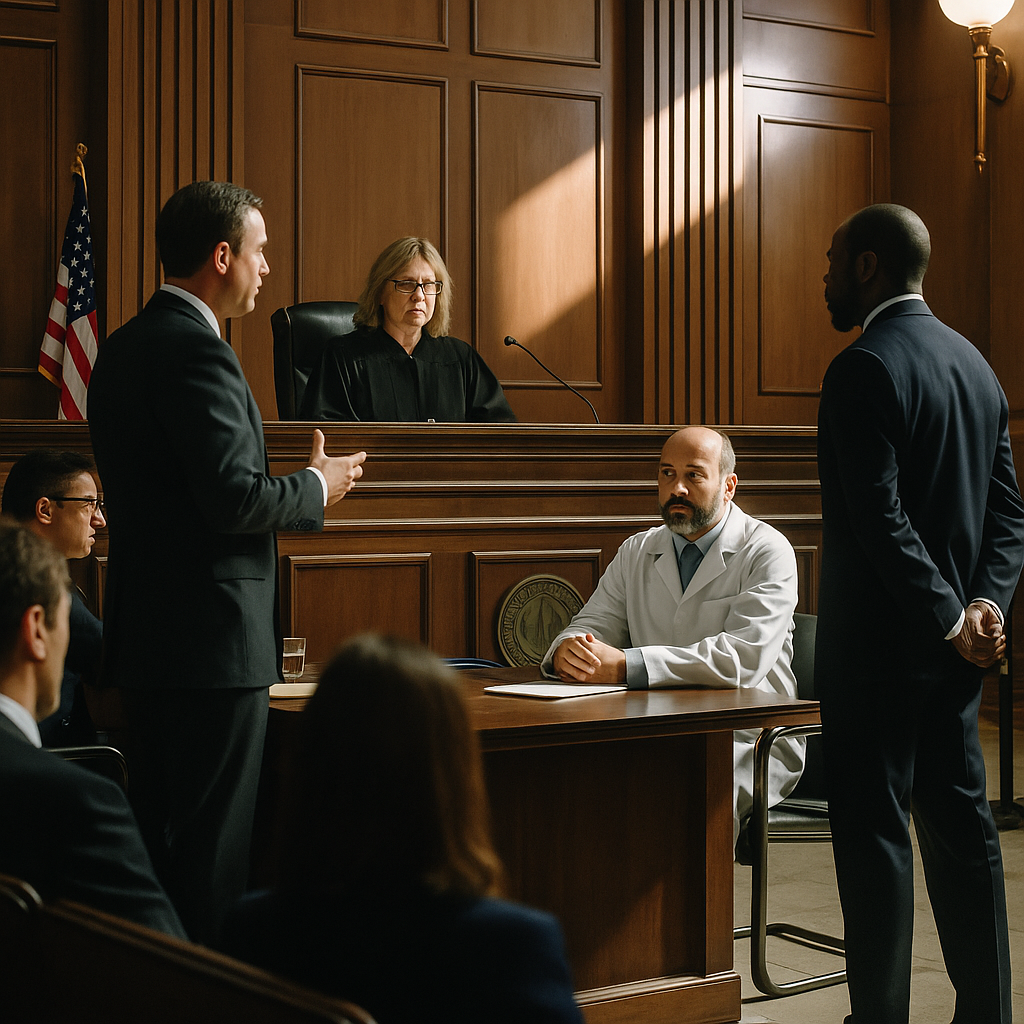The Cartiva Implant Lawsuit currently involves thousands of patients throughout the United States and Canada. They had undergone surgeries on their feet with the hope of obtaining long-term relief. There were many who anticipated relief from arthritis pain. Instead, they suffered from recurrent symptoms, nerve injury, bone loss, or even death. If you are among them, it is important to know your rights and choices.
This piece gives the full rundown of the Cartiva Implant Lawsuit, from how the device functions to what went wrong, how to seek compensation, and what you can expect in court. You’ll discover how to qualify, what records count, and how actual cases are influencing results. Every section builds on real developments and practical legal steps. If you’ve been injured by the Cartiva implant, this guide is for you.
What Is the Cartiva Implant?
The Cartiva Synthetic Cartilage Implant, often abbreviated as SCI, was designed to treat osteoarthritis of the big toe. The implant is made of a durable, water-based hydrogel. It’s intended to mimic the function of natural cartilage. Cartiva was meant to replace worn-out cartilage without requiring fusion of the toe joint. The procedure involved inserting the implant into the metatarsal bone of the big toe.
Surgeons believed it allowed better motion and faster recovery than toe fusion. Many patients opted for it to avoid permanent stiffness. It was also less invasive than older methods. Expectations were high, especially since it had FDA approval. Unfortunately, long-term use revealed critical flaws.
FDA Approval and Early Research
In 2016, the U.S. Food and Drug Administration granted premarket approval for Cartiva SCI. This approval came after the company submitted clinical trial results, primarily the MOTION study. That study tracked over 200 patients for two years. It claimed a low failure rate of about 13.5%. The data suggested Cartiva performed just as well as joint fusion.
On paper, these results looked positive. Hospitals quickly adopted the procedure. Surgeons recommended Cartiva as an advanced alternative. But the trial data had limits. The follow-up time was short. The patient sample was small. The study excluded certain risk groups. Many issues only emerged once the device was used widely.
The Promise That Failed
Patients initially saw Cartiva as a safe option. It let them walk again with less pain. Some returned to work quickly. Others resumed sports or daily routines. But these outcomes didn’t last for everyone.
Within months, many began reporting problems. The implant often shrank or sank into the bone. This condition, called subsidence, caused severe discomfort. Others developed cysts or experienced bone deterioration. Surgeons found the hydrogel degraded faster than expected. Patients returned with stiffness, nerve pain, or joint locking.
Many needed corrective surgeries. These included implant removal and toe fusion. Recovery was longer and more painful than the first operation. Instead of restoring motion, the implant sometimes caused permanent damage.
Thousands Affected
From 2016 to 2022, thousands of patients received the Cartiva implant. Over time, the number of complications increased. Medical databases collected dozens of adverse event reports. Surgeons began raising red flags. Some stopped using the device altogether.
Law firms now estimate over 10,000 patients may face long-term harm. Class action suits are under review. Individual claims flood federal and state courts. The Cartiva Implant Lawsuit has become a central legal battle over failed medical devices.
Symptoms After Cartiva Implant Failure
Complications often begin subtly but worsen over time. The following symptoms frequently appear in failed implant cases:
Pain and Burning
Persistent or returning pain is the first sign. It may feel sharp, throbbing, or like a burning sensation. Pain may increase during walking or pressure on the toe. Some patients struggle to wear shoes.
Stiffness or Immobility
The toe may become rigid. You may lose the ability to bend it. Limited motion leads to difficulty walking, climbing stairs, or balancing.
Swelling and Redness
Inflammation around the joint often signals trouble. Swelling can persist for weeks or return months after surgery. Redness, warmth, or tenderness indicate possible internal inflammation or infection.
Clicking or Grinding Feel
Patients may hear or feel a clicking in the joint. Grinding suggests erosion of surrounding cartilage or shifting of the implant. These are mechanical symptoms, often leading to revision.
Numbness or Nerve Pain
Nerve endings around the toe joint are sensitive. As the implant moves or shrinks, it may press on nearby nerves. This causes tingling, numbness, or electrical sensations.
Revision or Fusion Surgery Needed
Many require revision surgeries. Some remove the implant entirely. Others undergo fusion, a more invasive procedure. Bone grafts, screws, or plates may follow. Pain relief improves in some cases but motion is permanently reduced.
Why Did the Implant Fail?
Several design flaws explain the high failure rate:
- Hydrogel Composition: The Cartiva device consists of 79% water. Once implanted, body fluids alter its structure. Shrinkage occurs, reducing cushioning.
- No Fixation Mechanism: Unlike other implants, Cartiva lacks mechanical anchors. It relies on press-fit. That often fails to hold the device in place.
- Bone Erosion: As the implant sinks, it damages surrounding bone. This leads to cysts, osteolysis, and joint collapse.
- Lack of Longevity Data: Short-term studies could not predict how the device behaves over five or ten years.
These failures formed the core of the Cartiva Implant Lawsuit claims.
Was There a Recall?
Yes. In October 2024, Stryker, the manufacturer, recalled all Cartiva SCI units. The FDA classified this as a Class II recall. That designation means the product may cause temporary or medically reversible harm.
The recall covered devices sold since 2016. Hospitals were told to stop using Cartiva. Surgeons were advised to monitor past patients. Despite the recall, thousands had already suffered.
Critics argued the recall was overdue. Patient complaints started years earlier. Medical journals highlighted problems as early as 2018. Yet the manufacturer continued distribution. This delay forms a key issue in ongoing lawsuits.
Who Files the Cartiva Implant Lawsuit?
Affected patients file these lawsuits. Most have undergone revision surgery. Many report permanent damage or lost work time. Cases have been filed across multiple states. These include West Virginia, Illinois, Maryland, and Pennsylvania.
Defendants include Cartiva Inc., Wright Medical, and parent company Stryker. Plaintiffs argue they were misled about the product’s safety. They claim the manufacturer knew about the risks. Still, they continued to market the device.
The first federal trials are scheduled for 2025. Legal experts expect additional filings throughout 2026.
Legal Claims Explained
Several legal theories support the Cartiva Implant Lawsuit:
Defective Design
Plaintiffs argue the device was unsafe from the start. The lack of anchors, shrinking gel, and bone erosion point to a flawed product.
Failure to Warn
Many say they were never told about the true failure rate. Post-market data was not included in patient information.
Misrepresentation to FDA
Lawyers argue Cartiva provided limited or misleading data during approval. Adverse events may have been underreported.
Inadequate Testing
Critics highlight the short trial period and small sample size. The implant was rushed to market without long-term studies.
Timeline of Events
| Date | Event |
|---|---|
| 2016 | FDA approves the Cartiva implant |
| 2017–2022 | Surgeons implant device widely |
| Nov 2024 | Recall issued covering all models |
| Jan–May 2025 | New lawsuits filed across many states |
| Oct 28, 2025 | First federal trial scheduled in WV |
| Feb–Aug 2026 | Second trial rescheduling and deadlines |
This timeline shows the delay between approval and legal accountability.
Compensation and Settlement Size
Each situation is unique, but damages might encompass:
Medical Costs: Operation, imaging, physical therapy, medications, and future treatment.
Lost Wages: Time lost, cut hours, or loss of work because of mobility.
Pain and Suffering: Daily discomfort, loss of enjoyment, and mental stress.
Permanent Disability: Chronic stiffness or nerve impairment impacting lifestyle.
Punitive Damages: At times, to punish the manufacturer for neglect.
Lawyers estimate compensation may range from $20,000 to over $250,000. Larger settlements may follow if early trial results favor plaintiffs.
Real Patient Cases
Bryan Hughes
He received the implant in 2019. Symptoms began within a year. His revision surgery revealed implant sinking and bone damage. His trial begins in October 2025.
Tammy May
Implanted in 2022. She experienced swelling, pain, and nerve symptoms. She filed suit after needing fusion. Her case may lead 2026 trials.
Laura Kwasny
Her implant failed within 18 months. She endured nerve pain and walking issues. She joined others in filing coordinated lawsuits in Illinois.
How to Qualify for Your Case
You may qualify if:
- You received the Cartiva implant from 2016 to 2022.
- You now experience pain, loss of motion, or nerve damage.
- You required additional surgery to remove or correct the implant.
- You have supporting medical records and scans.
Consulting a law firm offers a clear review of your case. No payment is required unless you win.
What Evidence You Need
Your claim will need documentation:
- Surgical notes showing the implant placement
- Post-operative scans confirming failure or subsidence
- Doctor statements linking pain to the implant
- Records of medications, therapy, or secondary surgeries
- Work records showing income loss or disability
Detailed evidence improves your case’s strength and payout.
Common Defenses from the Company
Manufacturers often argue:
- The surgery was properly consented.
- Device warnings included failure risks.
- Surgeon technique caused complications.
- Other medical issues affected results.
Lawyers counter these with expert reviews, internal data, and real outcomes.
Risks of Not Acting
Legal time limits vary by state. Waiting can make your claim invalid. If you miss the deadline, no court will hear your case. You may also lose access to evidence and witness memory. Early action ensures stronger results.
Why the Cartiva Implant Lawsuit Matters to You
This lawsuit helps patients hold manufacturers accountable. It gives you a voice, supports recovery costs and prevents future harm to others. If your life changed due to a failed implant, your story matters. Legal action can bring clarity, closure, and change.
How This Compares to Other Device Lawsuits
This case resembles past failures:
- Hip implant recalls due to metal erosion
- Transvaginal mesh causing organ damage
- Essure birth control resulting in removals
Each case began small, then grew. Cartiva now follows that pattern. Justice builds one claim at a time.
How to Start
Steps to begin:
- Gather your medical and surgical records.
- List symptoms and complications post-surgery.
- Contact a qualified law firm handling implant claims.
- Submit documentation for review.
- Proceed with legal filing if your case qualifies.
Most lawyers take no fee unless you win.
Final Thoughts
The Cartiva Implant Lawsuit is a growing legal response to a failed medical device. Many patients live with pain, disability, or permanent damage. This guide explains your rights, what to expect, and how to act. You now know the background, symptoms, trial dates, and compensation amounts.
You can gather your records and contact experienced lawyers. The Cartiva Implant Lawsuit helps patients seek justice and support. It holds companies accountable for harm. If you received the implant and faced complications, don’t wait. Every case adds weight to the cause. This is your chance to act. Seek the help you deserve. Reclaim your health, your time, and your dignity.




